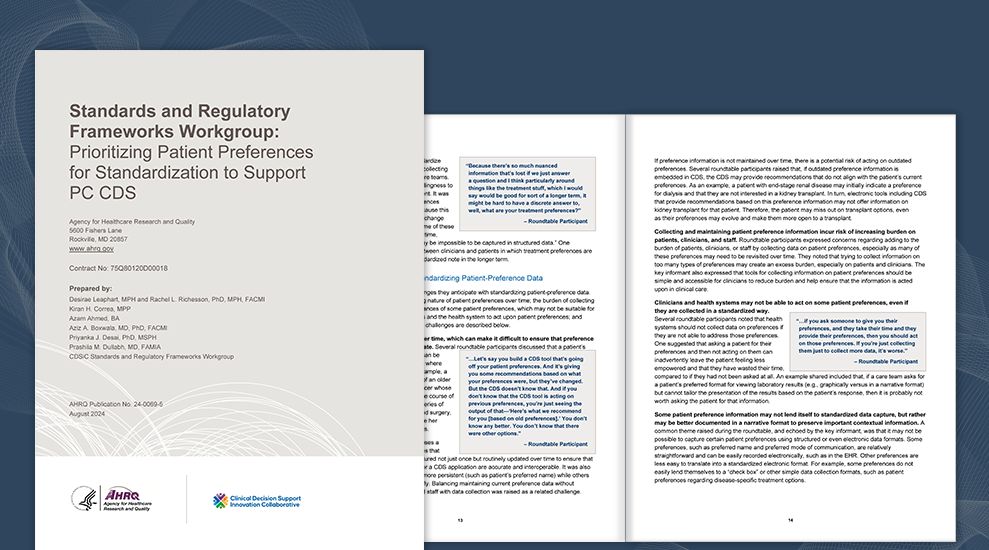
This report explores the standardization of patient preference information for inclusion in patient-centered clinical decision support.
Developed by the AHRQ Clinical Decision Support Innovation Collaborative’s Standards and Regulatory Frameworks Workgroup, this report identifies key themes related to the routine collection of patient preferences, patient information that should be prioritized for standardization, and challenges with standardizing patient preference information.
Patient preferences are the relative desirability or acceptability to patients of specified alternatives or choices among structures, processes, outcomes, or experiences of interactions with the healthcare delivery system. Patient preference information, when it is collected, is often collected as unstructured data in electronic health records and thus may not be used by clinicians or in digital health tools to inform patient care. Patient-centered clinical decision support (PC CDS) tools will have more impact when they can produce clinical recommendations that incorporate and account for patients’ preferences. This report explores the standardization of patient preference information for inclusion in PC CDS.
About the Report
A prior CDSiC report that describes available standards for patient preferences data concluded that some types of patient preferences can be encoded with existing terms in standardized codes and terminologies for use in PC CDS tools, but others cannot. As a result, patient preferences may not be seamlessly incorporated into PC CDS tools and recommendations.
Using information collected through a multistakeholder roundtable discussion and subsequent key informant interviews, this report discusses which patient preference concepts previously identified in the CDSiC Outcomes and Objectives Workgroup Taxonomy of Patient Preferences lend themselves best to standardization. It discusses the challenges associated with collecting patient preferences in a structured and standardized way and attempts to define priorities for patient preference standardization. Key themes that came through based on participant discussion include the following:
- Participants shared that generally their preferences as patients are not collected routinely as part of their healthcare.
- Participants discussed challenges they anticipate with standardizing patient-preference data.
- Preferences pertaining to engagement, access to information, communication, caregiving, and treatment were discussed as high priority for standardization.
- Participants shared that some preference information may be lower priority for standardization due to their sensitive nature or due to lack of feasibility and/or relevancy.
How To Use This Report
PC CDS tools will be more impactful when they can produce clinical recommendations that account for patients’ preferences. Ultimately, standardizing patient preference information can advance the incorporation of these data into PC CDS tools, enhancing their use for patient-centered care and shared decision making. The report provides four future directions related to additional research and recommendations for multistakeholder efforts to advance standardizing patient-preference data.
Suggested Citation: Leaphart D, Richesson RL, Correa KH, Ahmed A, Boxwala AA, Desai PJ, Dullabh PM, and the CDSiC Standards and Regulatory Frameworks Workgroup. Prioritizing Patient Preferences for Standardization to Support Patient-Centered Clinical Decision Support. Prepared under Contract No. 75Q80120D00018. AHRQ Publication No. 24-0069-5. Rockville, MD: Agency for Healthcare Research and Quality; August 2024.





